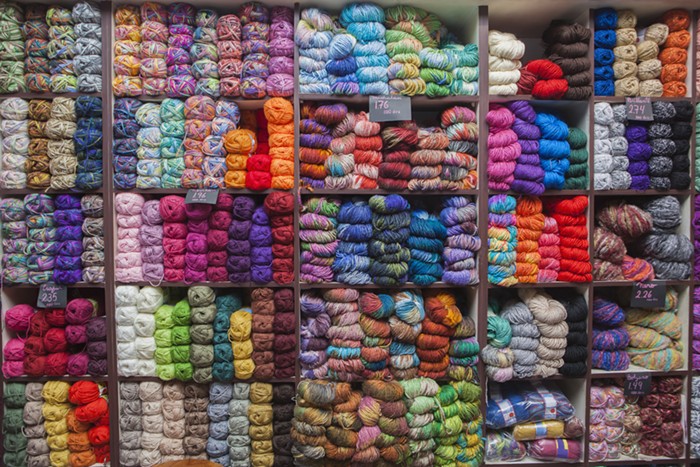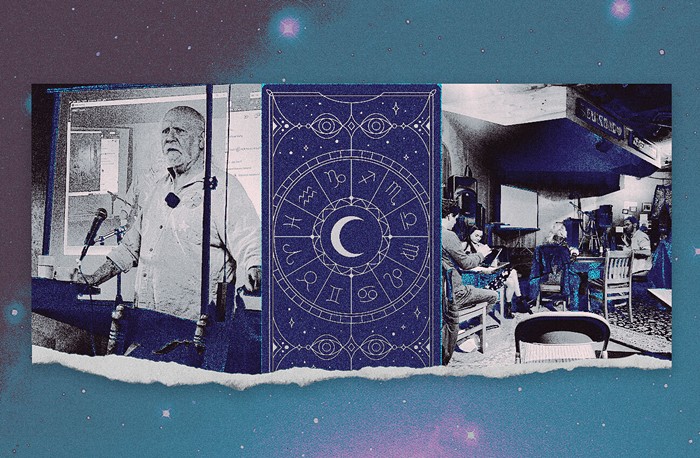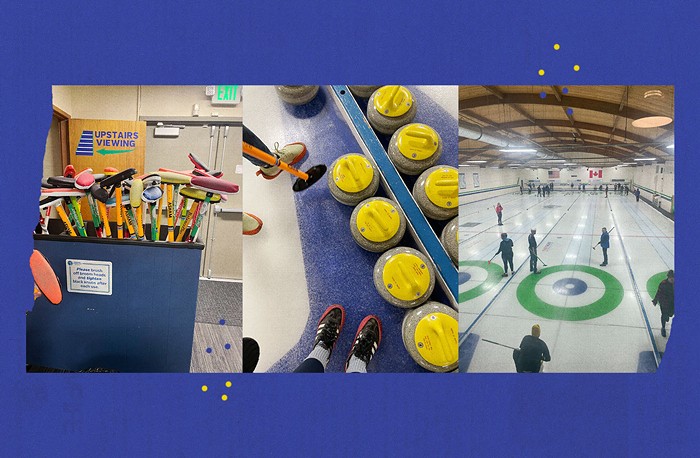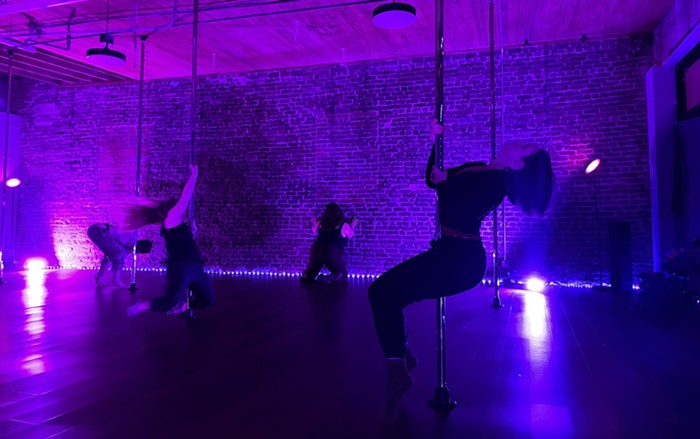I swallowed down desperate gulps of air from my snorkel. Pool water, too. My lungs burned. The water sloshed around me in waves, churning so much it looked like a boiling sea, the phenomenon natural historians ascribe to deep-ocean feeding frenzies. That felt apt, I thought, considering the action happening beneath me on the bottom of the Olympic-sized Snohomish Aquatic Center pool.
A tangle of bodies swarmed around the puck, upsetting the soft, suspended tranquility of being underwater. A woman broke from the mass and dolphin-kicked her way up one edge of the pool. A walrus of a man hurtled toward her, stopping her progress. He took the puck. She sped to the surface for air. The game continued in a blurred rhythm of lithe, slithering bodies jousting for control, then bailing to grab a sip of air above, and returning to the mess below.
This is underwater hockey.
I dove back down to join the mix, but after moving my body so much, I could only stay underwater for a few seconds before I felt the need to breathe again. I hightailed it to the pool wall, where the subs were hanging out, dodging fins and snorkels.
“Hey, you’re doing great!” John Kulsa, 55, told me. Kulsa, an IT specialist in his terrestrial life, has been playing underwater hockey for 37 years.
“I haven’t even touched the puck,” I said, breathing hard.
“Yeah, but you’re getting down,” Kulsa said. “A lot of first-timers don’t even get down.”
I nodded and probably said something about growing up in California and swimming a lot, but I couldn’t jot down any notes, so all of this is a soggy memory.
“How are you feeling?” Paul Byrne, 51, the only gay person on the Seahammers, said from behind a rainbow-trimmed mask.
“Cursing my lung capacity,” I said.
“Us too,” both men said.
“It gets easier,” Byrne said. “After about 15 minutes of this, your body will go into survival mode and you won’t need as much oxygen.”
Oh, okay, cool.
For my most recent dive into the world of Seattle subcultures, I joined the co-ed Seattle Seahammers for one of their two weekly practices. ("Seahammer" is a nautical portmanteau of Seattle and Bellingham. Members live all over western Washington, but most live closer to Seattle than Bellingham.)
Kulsa has been on the Seahammers since the club started 34 years ago. Byrne has been playing since he moved to Seattle for law school in 2006. The two of them, plus the rest of the people who showed up Saturday evening, showed me the ropes after they threw me into the deep end—metaphorically speaking, that is. The Seahammers actually play in the seven-foot-deep shallow end.
During my two-hour underwater hockey intensive, I came face-to-face with the limits of my own lungs, met a tight-knit community of competitive weirdos, and fell in love with a one-of-a-kind sport.
Aquatic Gentrification
The Seahammers practiced in the Seattle University pool for around 25 years until the pool changed its policies and raised its rates. With pools limited in Seattle, the Seahammers now practice in Snohomish and Edmonds. They lost their space at the YMCA in SeaTac due to COVID-induced lifeguard shortages.
The practice I attended was more intense than a normal practice since several of the Seahammers are training for the national championship in June (it’s in Minnesota) and the world championship in July (it’s in Australia). Several members of the Canadian National Team drove down from Vancouver, B.C. to Snohomish just to scrimmage. They planned to drive home after the practice ended at 9:00 pm.
Before the practice started, I stripped down to my swimsuit, tucked my hair into a spandex swim cap, and lubed up my feet with petroleum jelly so they wouldn’t chafe inside my fins.
All around me, men in speedos and women in one-piece swimsuits aged in their mid-20s to mid-50s readied themselves for the scrimmage, tying on their water polo ear muffs and spitting in their masks as a form of DIY-defogger.
“The first time you play it feels like drowning,” Alita Krickan, 43, a member of the Canadian National Team told me with a smile.
She was getting ready next to me. Krickan loves the sport so much she played until her due date when she was pregnant with her second child. She said she swam faster after she gave birth, as if she’d spent nine months doing resistance training. Her pregnant underwater hockeying is even more impressive when you consider underwater hockey’s history.
What the Fuck Is Underwater Hockey?
The British Navy invented underwater hockey in the 1950s to train naval divers. The sport helped with physical fitness and taught the divers how to communicate and move underwater. Now, teams in over 20 countries squirm around on the bottom of pools all around the world, playing the sport for fun.
A typical underwater hockey game consists of two teams of six trying to score a three-pound puck into the other team’s goal. The game starts with each team positioned at opposite ends of the pool. A ref (one out of the water, two in the water) yells “sticks up!” and then the game starts. Players push off the walls, swimming full speed toward the puck in the middle of the pool. Like launching submarines, players descend down to the puck, racing to get their stick on it first. Then, normal hockey behavior happens—except no one can breathe.
Players push the puck along the bottom with 10-inch sticks they hold in one gloved hand. They can also flick the puck and hurl it through the water in the same motion you’d use to throw a frisbee. The other crucial move is a curl, where a player stops their forward motion by abruptly turning their body, thus protecting any oncoming attackers. However, this move isn’t foolproof when your attacker is coming from above.
That’s the thing about underwater hockey—there’s a whole other dimension to keep track of.
“There’s this three-dimensional nature of the sport that you don’t get in other sports,” Decker Onken, 27, said. “Not only do you have left and right, forward and backwards, but you also have the depth of the pool to deal with.”
The depth allows people to attack the puck from above, but it also mandates strategizing around breath.
“You have to know the timing of not only yourself and how much breath you can hold and how long you can stay under water, but also your teammates' and how long they can hold their breath,” Christina Jones, 34, said.
The Seahammers are a co-ed team, and most of the tournaments they play are co-ed. The water is an equalizer for all genders; though it helps, brute strength isn’t enough to win a game. A solid underwater hockey team needs teamwork and communication.
“You’re timing and cycling with people,” Jones said. “It’s coordination you have without communicating.”
When you’re underwater, you can’t call for the puck, you can’t warn teammates about an oncoming defender. It’s mostly silent despite the flurry of activity.
"You have to go off of body signals and cues,” Jones said. “It’s a silent dance that we’re doing under the water.”
I asked Onken how the fans watch, since all the action takes place underwater. He sort of laughed, “Well, uh, we don’t really have many outside spectators.” If other players or family members want to watch, they have to get in the pool.
Even though more countries than ever are playing in this year’s world championships (China is sending a team for the first time!) and more and more teams are cropping up in the U.S., underwater hockey is still a pretty underground sport. So, how did these people even hear about it?
A "Special Breed"
Most people who find their way to underwater hockey come from a swimming background. (That said, one time a newcomer did show up to practice not knowing how to swim, and he's still on the team).
“Water people keep doing water activities,” Kulsa remarked. A lifelong swimmer, he discovered underwater hockey as a freshman at Western Washington University in 1986. Back then, people were using garden gloves and hot glue instead of the specially made underwater hockey gloves players use now, Kulsa said.
Jones found the sport as a Texas high schooler when a woman interrupted her swimming laps and asked if she wanted to try something more competitive. Jones now plays on the Seahammers as well as the U.S. Women’s National Team. She’s been to multiple world championship tournaments.
“I love being underwater,” Jones said. “I feel like a mermaid.”
For Jones, who met her fiancé at a tournament in Denver 15 years ago and partially chose Seattle do her PhD in pharmacology because it had an underwater hockey team, the community is the most important thing to her.
Even though she didn’t know anyone in Seattle when she moved here, Jones had people she knew from hockey tournaments. She has friends across the country and around the world. And the Seahammers do way more together than just play hockey—they’re like a family. They go out to dinner, they hike, they throw house-warming parties in Arlington after their three-hour scrimmages against Canadians.
Underwater hockey people connect easily because their temperaments have to be somewhat similar to play a sport like this. Jones called them a "special breed."
“In order to love underwater hockey you have to be weird,” Byrne said, “because why on earth would you hold your breath over and over and feel like you’re going to die over and over?”
Chum in the Water
I actually entered the fray at the bottom of the pool after we were already three goals into the scrimmage. I wormed my way into the scrum, my stick at-the-ready.
Onken shot me a pass through a seam of people. I collected it with my stick, turned my body, and then kicked furiously toward the goal. I felt like I was a kid again trying to swim the entire length of a pool underwater. Currents of water streamed past my face.
I should probably breathe soon, I thought, pushing myself further. And where is everyone? Surely, I wasn’t faster than all these players. I tilted my head to see past my mask’s peripheral blindspot. Oh, there were people on either side of me gaining fast. A shadow swooped down from above me. Fuck.
The goal was right there, but I couldn’t stay down here much longer. I couldn’t just abandon the puck and hand it over to the other team. I curled my body around it, turned abruptly, and pushed the puck feebly toward someone who might have been on my team. Someone's fin kicked me as I shot up toward an inhale. I threw my head back as I broke the surface like a shaking, gasping Ariel, and breathed. My teammate who’d taken the puck after me scored.
Freed from their underwater silences, players around me chattered excitedly. My heart pounded in my chest. Holy shit. My entire body pulsed with the exertion. Onken and Kulsa shot me thumbs ups from across the pool. I beamed.
I hadn’t had this much fun in a pool since my family caught my brother cheating during "Marco Polo" and we put tin foil in his goggles. Even then, "Marco Polo" was never that fun. Underwater hockey, with its competitive rush and high-stakes restrictions, was. I played for two hours and would’ve played for a third if I didn’t feel an alveolar collapse around the corner.
Climbing out of the pool and toweling off, I watched the choppy waters rough up the shallow end. Fins appeared and disappeared as people surfaced and dove. Part of me longed for the bottom of the pool. As I left, my muscles tired and a bruise blooming under the tattoo on my arm, I couldn't shake the feeling that this wasn't my last underwater hockey practice.
Any ideas on which Seattle subculture I should explore next? Want me to tag along with you on your favorite hobby or pastime? Send me tips at playdate@thestranger.com.




















